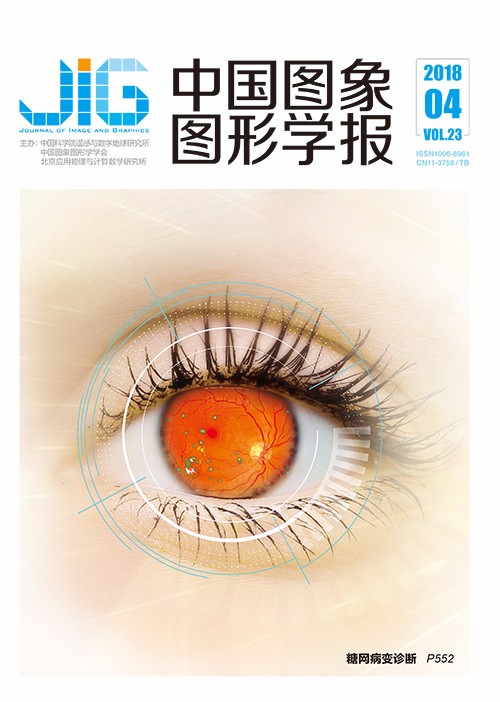
结合深度学习和支持向量机的海马子区图像分割
摘 要
目的 由于海马子区体积很小且结构复杂,传统的分割方法无法达到理想的分割效果,为此提出一种基于卷积神经网络和支持向量机的海马子区分割方法。方法 该方法构建一种新模型,将卷积神经网络和支持向量机结合起来,使用支持向量机分类器替换卷积神经网络的输出层,通过训练深层网络自动提取图像块特征,利用所提取的图像特征训练支持向量机实现图像的像素级分类。结果 实验选取美国旧金山CIND中心的32位实验者的脑部磁共振图像(MRI)进行海马子区分割测试,在定性和定量方面分别对比了本文方法与支持向量机(SVM)、卷积神经网络(CNN)和基于稀疏表示与字典学习方法的分割结果。所提方法对海马子区CA1、CA2、DG、CA3、Head、Tail、SUB、ERC和PHG的分割准确率分别为0.969、0.733、0.967、0.837、0.981、0.920、0.972、0.968和0.976。本文方法优于现有的基于稀疏表示与字典学习、支持向量机和卷积神经网络的方法,各海马子区分割准确率均有较大提升,对较大子区如Head,准确率较现有最优方法提升10.2%,对较小子区如CA2、CA3,准确率分别有36.2%和52.7%的大幅提升。结论 本文方法有效提升了海马子区的分割准确率,可用于大脑核磁共振图像中海马及其子区的准确分割,为诸多神经退行性疾病的临床诊断与治疗提供依据。
关键词
Segmentation of hippocampal subfields by using deep learning and support vector machine
Shi Yonggang, Cheng Kun, Liu Zhiwen(School of Information and Electronics, Beijing Institute of Technology, Beijing 100081, China) Abstract
Objective Numerous clinical studies have shown that changes in the volume or morphology of the hippocampus and its subfields are closely related to many neuro degenerative diseases, such as Alzheimer's disease and mild cognitive impairment. Accurate segmentation of hippocampus and its subfields from the brain magnetic resonance imaging, which is a prerequisite for volume measurement, plays a significant role in the clinical diagnosis and treatment of many neurodegenerative diseases. Despite significant progress in recent decades, hippocampal subfield segmentation remains a challenging task mainly because the volume of hippocampal subfields is too small and the boundaries of subfields are insufficiently distinctive to extract. Traditional hippocampal segmentation, which involves methods based on multi-atlas, sparse representation, and shallow network, cannot achieve satisfactory segmentation. By contrast, some methods that use image features extracted by convolutional neural networks (CNNs) have demonstrated state-of-the-art results on a wide range of image segmentation tasks. In this study, a hippocampal subfield segmentation approach based on CNN and support vector machine (SVM) is proposed. These two models are combined to exploit their individual advantages to further improve the accuracy of hippocampal subfield segmentation.Method The proposed approach constructs a new model that combines CNN and SVM.Magnetic resonance image patches centered at the target pixel point are fed to the network as input images. After a series of convolution and downsampling operations, output image features of a fully connected layer are used as the inputs of SVM. SVM is trained with the features to implement the pixel classification of images. The CNN consists of an input layer, three convolution layers, three downsampling layers, a fully connected layer, and an output layer, where the downsampling layer can provide numerous abstract features for image segmentation tasks. Data augmentation is employed to expand labeled data by adding Gaussian noise and rotation operations to prevent overfitting. The new model overcomes the shortcomings of CNN and SVM by combining their advantages. The learning principle of the CNN classifier, which is basically the same as that of multilayer perceptron, is easy to fall into a local minimum due to the training network to minimize classification errors by minimizing experience risks. SVM is based on the principle of structural risk minimization to minimize the generalization error of training set data. By solving the quadratic programming problem, SVM obtains a hyperplane that is the global optimal solution, thereby effectively avoiding the local optimum. Therefore, the generalization capability of the new model is significantly improved. Result In the experiment, the proposed approach is tested on the brain magnetic resonance images of 32 volunteers from the Center for Imaging of Neurodegenerative Diseases in San Francisco, California, USA. The approach is qualitatively and quantitatively compared with methods based on SVM, CNN, and sparse representation and dictionary learning in the first part of the experiment. The segmentation Dice similarity coefficients (DSCs) of the proposed approach for Cornu Ammonis (CA)1, CA2, dentate gyrus, CA3, head, tail, subiculum, entorhinal cortex, and parahippocampal gyrus in the hippocampal subfields are 0.969, 0.733, 0.977, 0.987, 0.981, 0.982, 0.972, 0.986, and 0.976, respectively. The comparisons demonstrate that the proposed method, which achieves significantly improved accuracy of all the hippocampal subfields, outperforms the existing methods based on dictionary learning and sparse representation and multi-atlas. For the large subfields, such as head of hippocampus, the DSC is increased by 10.2% compared with those of the state-of-the-art approaches. For the small subfields, such as CA2 and CA3, the segmentation accuracies are also significantly increased by 36.2% and 52.7%, respectively. The effects of image patch size, number of convolution layer, and number of convolution layer features on the segmentation results are tested with a control variable method in the second part of the experiment. Conclusion In this study, CNN is introduced to extract image features automatically, and SVM, instead of CNN classifier, is used to classify image pixels. The proposed method,which can improve the generalization capability of the classifier,overcomes the shortcomings of most other traditional classifiers that largely rely on the retrieval of good hand-designed features, which is a laborious and time-consuming task. Experimental results prove that the proposed method can effectively improve the segmentation accuracy of hippocampal subfields in brain magnetic resonance images, which provide the basis for the clinical diagnosis and treatment of many neurodegenerative diseases.Future work includes reducing the computation time of the algorithm, improving the segmentation accuracy of small hippocampal subfields by optimizing the algorithm, and extending the proposed network to the segmentation of other organs by fine-tuning the network parameters.
Keywords
medical image processing hippocampal subfields segmentation convolution neural network (CNN) support vector machine (SVM) image feature feature extraction
|



 中国图象图形学报 │ 京ICP备05080539号-4 │ 本系统由
中国图象图形学报 │ 京ICP备05080539号-4 │ 本系统由